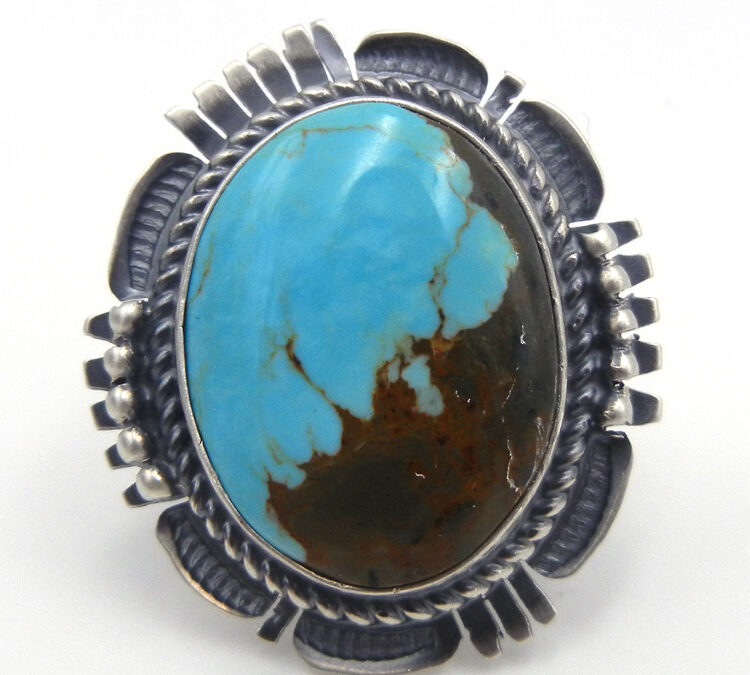Turquoise has been a coveted stone since ancient times and is still highly sought after today. As the cornerstone of Navajo culture, you’ll see turquoise used in jewelry, art, and various ceremonial objects.
At Palms Trading Company, we buy our jewelry directly from the artisans, ensuring that the Navajo men’s turquoise rings and other jewelry we sell are authentic. Here is some background about how turquoise is formed, its cultural significance to the Navajo people, and the kinds of turquoise you’ll see today.
What is turquoise?
Turquoise is a semi-precious stone derived from the earth. It is a hydrous phosphate of copper and aluminum, usually with a blue to greenish-blue color. The name turquoise comes from the French word ‘Turquie,’ which means “Turkish stone” due to its popularity in Turkey during the Ottoman Empire.
How is turquoise formed?
The formation of turquoise starts deep within the Earth’s crust, where underground pools of hydrothermal fluid suspend minerals. As this fluid mixes with limestone or sandstone deposits, it builds up copper and aluminum oxide concentrations.
These elements begin to crystallize around other elements like phosphorus, silica, and manganese. When all these elements combine, they form a hydrous phosphate that gives turquoise its signature blue-green hue.
Matrix
You’ll often see darker lines or blotches of color embedded into turquoise stones. This is what is referred to as the matrix. The matrix comes from the mother or hosting rock, which is limestone or sandstone.
Limestone produces dark brown markings, while sandstone usually produces lighter tan colored markings.
Environmental Factors
One of the reasons why turquoise has become a rare commodity is because it can only form in specialized environments. First, turquoise only forms in dry, arid climates. That’s why the turquoise mines existing in the US are in our desert regions.
As mentioned before, turquoise must also form within a sandstone or limestone hosting rock and be exposed to other specific elements to create this semi-precious stone. Very few regions in the world provide the minerals and climate necessary for turquoise to form, making it a rare stone.
How is turquoise mined?
Turquoise stones are mined in various ways, with the most common method being open-pit mining. This involves digging deep trenches and using pickaxes to break up the rock containing the turquoise. The material is then sifted through screens to remove any dirt or rock that doesn’t contain turquoise.
Depleting Mines
Another factor making natural turquoise more valuable is that many US mines have become depleted over the decades.
For example, the Cerillos mine in New Mexico opened during the 1800s and provided an abundant source of turquoise for the Navajo people in the Southwest region. Through the turquoise booms and periods of low demand, this mine eventually depleted and no longer produces turquoise today.
Cerillos is no exception, though. Many US mines have become depleted, making natural turquoise harder to find and more valuable than ever.
History of Navajo Men’s Turquoise Rings
The history of Navajo men’s turquoise rings dates back centuries.
Introduction of Silversmithing
During the mid-1800s, the Spaniards began entering the US Southwestern territories. These Spaniards adorned themselves and even their horses with silver embellishments never seen by the Navajo before.
In his quest to figure out how to make these adornments himself, Atsidi Sani, a Navajo blacksmith, convinced a Spanish silversmith to teach him this trade. The Spaniards first taught Sani how to make conchos and other silver embellishments.
From there, Sani taught his sons and other artisans how to silversmith, establishing the foundations that led to the jewelry creations you see today.
Cultural Significance
Before silversmithing, Navajo tribes used turquoise for its protective powers. Warriors took turquoise with them into battle while turquoise hung in homes to ward off evil spirits. The Navajo also saw turquoise as a bringer of prosperity, which meant hunters took turquoise with them to help them bring back bountiful contributions.
The introduction of silversmithing made it easier for the Navajo to utilize and wear turquoise.
Navajo men’s turquoise rings were used during spiritual ceremonies, while some wore them as symbols of wealth and status.
Today, these rings are still widely worn for their cultural significance and meaning, often as wedding bands or engagement rings in traditional ceremonies. The symbolism behind them is one of protection and healing, believed to bring luck to the wearer.
Can non-indigenous people wear Navajo men’s turquoise rings?
Navajo turquoise jewelry has been popular among tourists and non-indigenous people since the late 1800s. Spurred by the Transcontinental Railroad, Navajo jewelry became a necessary collectible among visiting tourists.
While Navajo jewelry remains a popular choice for southwestern and bohemian fashion styles, it’s essential to always be culturally aware and respectful towards Native American tribes, cultures, and beliefs.
With that in mind, wearing Navajo jewelry as a non-indigenous person is acceptable. To ensure you’re buying authentic Navajo creations, always buy from a reputable dealer that transparently marks authentication and can openly tell you about the artisans making the jewelry.
Stabilized vs. Natural Turquoise
As mines depleted, stabilizing turquoise became a necessity. Stabilized turquoise is turquoise that has undergone treatment to make the generally soft stone harder and more stable for jewelry making.
Between the depletion of mines and the large amounts of stabilized turquoise hitting the markets, natural turquoise is now rarer and more valuable than ever, which is why buying your Navajo jewelry from a reputable seller is crucial. They’ll have the expertise to authenticate turquoise, letting you know exactly what you’re buying.
Where To Find Authentic Navajo Men’s Turquoise Rings
At Palms Trading Company, our decades of experience mean we can ensure that the Navajo jewelry you buy is authentic. We work directly with the artisans, clearly label all the metals and stones used in each piece, and can provide you with accurate information about each piece we carry.
Check out our Albuquerque store or shop online today to view our elegant collection of men’s turquoise rings and other jewelry pieces!



